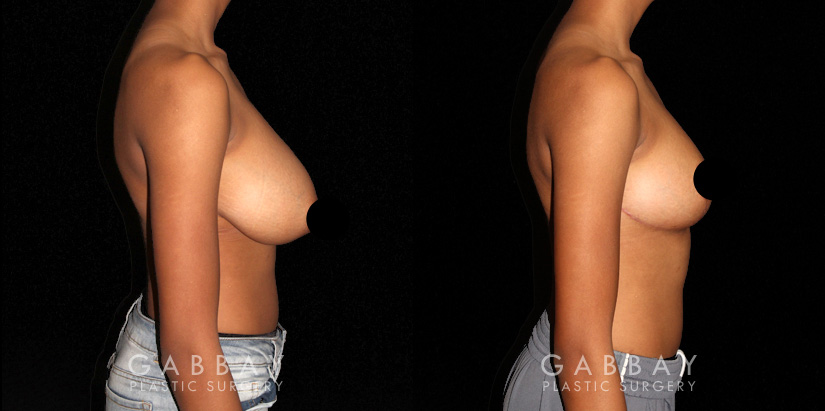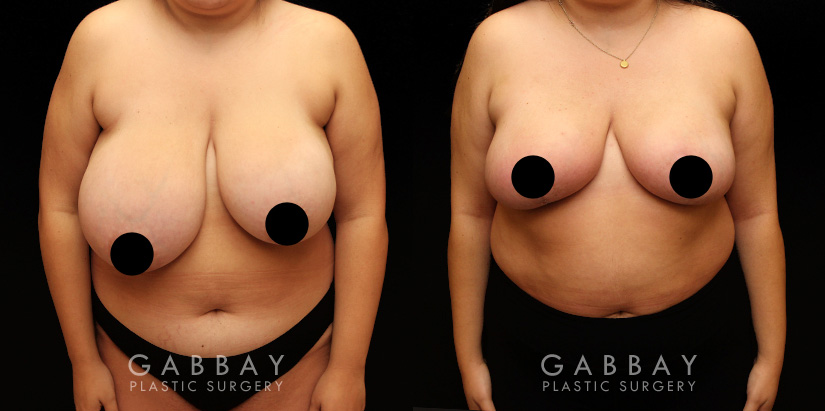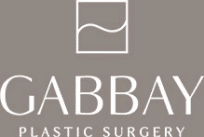Breast Reduction
For many women, large breasts can cause many physical and aesthetic complications. However, a breast reduction can help you take control over your body and improve both your health and quality of life. Also called reduction mammoplasty, this procedure allows you to decrease the size of your breasts according to your goals.
At Gabbay Plastic Surgery, our focus is on helping patients achieve the body that is best for them. If large breasts affect your quality of life, we may be able to help. Call us today to learn more about breast reduction and our full suite of procedures.
Table of Contents
What Is Breast Reduction?
Breast reduction is a surgical procedure to reduce the size of your breasts. While size can be a factor in attraction, all too often, large breasts can cause patients a range of physical problems. Common issues include
- Chronic back pain
- Headaches
- Breathing problems
- Poor posture
- Neck strain
- Skin irritation
- Deep, painful indentations from bra straps
Breast size may also inhibit lifestyle choices. For many, they make physical activity, sports, and exercise incredibly challenging. The end result is decreased mobility and increased potential for weight gain.
Procedure Overview
Breast reduction surgery is typically performed on an outpatient basis, so you can return home the same day. During the procedure, you will be under general anesthesia and completely comfortable. Procedure times vary depending on the extent of reduction. However, the procedure generally can take 2-3 hours to complete.
Once the incision is made, Dr. Gabbay will remove excess skin, tissue, and fat. He then shifts the nipple-areolar complex to a higher position for cosmetic purposes. Excess fat may also be removed through liposuction or other techniques to improve contouring.
Drainage tubes will be inserted at the end of the surgery to drain fluid but are removed 1-2 days after your surgery. The incision site will then be sutured with dissolvable stitches. We wrap your chest in special gauze before you are taken to the recovery room. If everything looks good, you can go home.
Benefits of Breast Reduction
- Improved comfort
Reduction in physical symptoms - Boosted confidence
- Long-lasting results
- Broader range of clothing options
- Increased mobility
How Can I Prepare for the Procedure?
- Pause taking any blood-thinning medication and supplements
- Obtain blood work results and any other specified analyses
- Schedule time off from work
- Avoid smoking and excess drinking
- Arrange for someone to drive you home from surgery
- Arrange for someone to help you around the house for the first few days
- Ask for clarification from Dr. Gabbay regarding any questions you have
Types of Breast Reduction Surgery
- Inferior Pedicle Technique: Provides a youthful lift to the breast.
- Vertical Technique: Maintains the functionality of the nipple.
- Horizontal Technique: Best for women whose breasts are too large for the vertical scar technique.
- Standard Reduction: Best suited for women with large breasts suffering from severe breast sagging.
- Free Nipple-Graft Technique: Allows large amounts of tissue to be removed, but leaves the nipple without functionality.
- Liposuction: Effective for women who only need a small amount of tissue removal. It can be performed along with other techniques.

Gallery
Is Breast Reduction Right for Me?
Choosing breast reduction can often be a challenging choice. However, the outcomes bring a range of new benefits to patients and improved quality of life. If large breasts are causing you discomfort or other problems, this procedure may be right for you.
- Loss of sensation in the arms or fingers
- Scar-like lines
- Chronic back pain
Headaches - Shoulder and neck pain
- Poor posture
- Bra-strap grooves
- Numbness in the breasts or upper chest
- Skin rashes under the breasts
- Inability to exercise and restricted movement
- Pendulous breasts with nipples and areolas that point downward
- Asymmetrical breasts
- Self-consciousness about size
What Is the Consultation Like?
The first step to becoming a candidate is to call Gabbay Plastic Surgery and schedule a complimentary consultation. During your visit, Dr. Gabbay will:
- Discuss specific surgical goals
- Cover your detailed medical history
- Assess your physical and emotional health
If the surgery is a good option for you, Dr. Gabbay will explain what your procedure will look like and go over every detail with you first. You will be encouraged to voice any concerns in an open discussion. This way, you and Dr. Gabbay can decide together on the best treatment options to achieve your goals. He will then create a customized treatment plan based on:
- Size and shape of your breasts
- Quality of your skin
- Position of your nipples
- Your individual needs
Does insurance cover breast reduction?
Yes, the American Society of Plastic Surgeons (ASPS) classifies breast reduction surgery as a reconstructive procedure. The reason is that it is most often performed to correct a physical or medical problem rather than strictly to improve one’s appearance. For this reason, insurance may cover the procedure’s costs.
The amount covered will vary based on your provider and individual plan. We recommend speaking with an insurance representative to understand your plan details and how much they cover for breast reduction. Insurance may also provide coverage for a breast reduction combined with a breast lift when lifting is also medically necessary.
Schedule a Consultation
Frequently Asked Questions
How much does breast reduction cost?
While insurance can cover much of the procedure, the remaining cost can vary notably. Dr. Gabbay gladly works with patients to explore financing options for the out-of-pocket costs of the procedure. We offer several breast reduction financing options through Alphaeon and CareCredit, opening the door to care for a broader range of patients. Breast reduction can prove life-changing for patients, so we want to do our part to help make the procedure possible.
Who qualifies for breast reduction surgery?
Dr. Gabbay uses the consultation to ensure a potential patient can be a good candidate for breast reduction. The procedure involves invasive methods, so we take every precaution to make sure a candidate’s health profile matches the safety requirements.
- Physical Requirements: Patients must be in overall good health. Certain medical conditions or diseases could increase a patient’s procedure risks, so we must ensure those are addressed first. Additionally, patients will be at or near their ideal stable weight. Significant weight fluctuations can alter your results.
- Psychological Requirements: Patients will need to fully understand the procedure, its limitations, and its risks. Having healthy, clear expectations leads to greater long-term patient satisfaction.
What is the recovery like?
After your breast reduction surgery, you will have some discomfort for the first couple of days. However, any pain can be controlled with medication as needed. Over-the-counter pain relievers often prove sufficient. However, we may prescribe pain medication when appropriate.
To ensure optimal and quicker healing, we provide you with a complete list of recovery instructions. Examples include keeping dressing clean and wearing a support bra. While healing, you will also need to rest and limit movement. Doing so speeds up the healing process and reduces recovery time.
Initial recovery involves pausing all physical activity. For the first few days in particular, we recommend patients arrange for someone to help them around the house. After discussing your recovery in follow-up visits, Dr. Gabbay can recommend a gradual return to exercise and other physical activity.
How much downtime should I expect?
Most patients take 1 to 2 weeks off work for the initial downtime and recovery period. During this time, getting rest will be ideal for helping your recovery. Dr. Gabbay will let you know when you are ready to return to your usual routine and activities.
Downtime should never be rushed. We know patients will want to return to their daily routine as soon as possible. However, the wait proves more than worth it. Rushing out of downtime can put your results and your health at risk. Take the time needed to rest, and let your breasts heal fully. Then, you can enjoy your results for a lifetime.
When can I see my breast reduction results?
Following surgery, your breasts will see immediate results. However, you might not be able to enjoy the benefits until you heal for a few days. Once the initial swelling, discomfort, and bruising resolve, only the benefits should be noticeable.
The final shape and size may not be evident until healing is complete and all swelling has gone down. Residual swelling can take several months to fade. While such swelling is not necessarily visible, it does affect how the breasts’ tissues sit. You should be able to see your final results within six months after all tissue settles into its final position.
What are breast reduction results like?
Most patients report almost immediate improvements for most of their concerns. Most notably, the improved comfort stands out. Other symptoms like rashes should should also be a problem of the past. However, remember that weight fluctuations can still influence breast size. So, maintaining a healthy lifestyle can help you get the most out of your breasts.
What size will my breasts be afterward?
Breast size after a reduction usually depends on patient preference. Most patients will see a reduction of between 1 and 3 cup sizes. This equates to removing about 100 to 300 grams of breast tissue. More intensive reduction is possible, but only in select cases.
Final breast size depends on the initial size of your breasts and how much tissue must be removed to improve your condition. Most patients will have a C or D cup following their procedure.
Will I have visible scars after a breast reduction?
The incisions made during a breast reduction procedure will heal as scars. However, their visibility can vary. Whenever possible, Dr. Gabbay makes incisions under the breast so that any scars will be hidden. More extensive reduction may require different incision techniques that may result in more visible scarring. Even in these cases, Dr. Gabbay shapes the incisions to follow the breast’s natural shape, minimizing how much they stand out.
Additionally, scars should fade over time. Following all your post-op instructions will promote better healing, leading to less initial scarring. We also offer nonsurgical treatments that can further reduce scarring once you have finished recovering.
Will my nipple sensation change?
Some breast reduction techniques can affect nipple sensitivity. Each procedure plan weighs the patient’s goals, including final breast size and preserved breast function. The techniques that best spare nipple function are those used for less extensive reduction.
Can I combine breast reduction with a breast lift?
You certainly can. In fact, a breast lift is the most commonly combined procedure with breast reduction. Patients who plan to have a milder breast reduction might not need a lift. However, any patient having a significant reduction may want to consider combining it with a breast lift.
A breast lift improves the position of the breasts, bringing them up to a more natural or youthful position. This lifted position further improves concerns such as rashes under the breasts by decreasing the amount of skin contact and space for moisture to become trapped.
Will breast reduction affect breastfeeding?
Some breast reduction techniques can affect a patient’s ability to breastfeed. Whenever possible, Dr. Gabbay uses an approach that preserves breast function, including nipple sensitivity. However, the technique required will usually depend on the patient’s goals and how much they want to reduce their breast size. Dr. Gabbay will go over these potential risks during the consultation.





